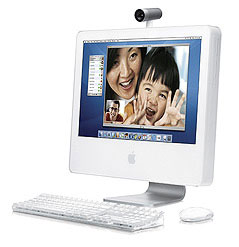 |
 |
||||
 |
||
Mac's cost less… and are better! |
Apple's Latest iMac Is Elegant, Powerful, Surprisingly Affordable
By WALTER S. MOSSBERG
I am writing these words on the most elegant desktop computer I've ever used, a computer that is not only uncommonly beautiful but fast and powerful, virus-free and surprisingly affordable.
This machine takes up no more space on a desk than a flat-panel monitor. In fact, the entire computer is contained behind a flat-panel screen in a space just 2 inches thick -- thinner than most flat-panel monitors alone.
Yet it houses one of the most advanced processors on the market; a roomy hard disk; a CD or DVD recorder; wired or wireless Internet connectivity; and a full complement of ports and connectors.
I'm talking about Apple Computer's new iMac G5 desktop, which starts at $1,299 for a model with a 17-inch wide-screen display, and rises to $1,899 for a version with a massive 20-inch wide-screen display. It's another design coup by Apple.
This is the third major iteration of the iMac, Apple's stylish consumer machine that features a built-in monitor. But now the computer's guts have been shrunk to the point where they are essentially invisible. And this version uses the G5 processor, a chip that is in some respects more powerful than the Intel Pentium processors that power most Windows computers.
The iMac G5 isn't the first computer to be crammed into the back of a flat-panel display. But the iMac is much thinner and more attractive than the others.

Apple has enclosed the computer in a gleaming white body trimmed with a clear border that gives the whole thing an airy, floating feeling. The machine sits atop a built-in, adjustable aluminum stand.
A wide selection of ports and connectors is arrayed in a neat vertical lineup on the back. A hole in the aluminum stand feeds any cords away from the machine and out of sight. You can actually reduce the whole thing to just two cords -- a power cord and a printer cord -- by adding a wireless keyboard and mouse, for an extra $99, and a wireless networking card, for $79.
The new iMac has three fans, but they are so quiet that the computer was nearly silent in my tests, much quieter than my Windows desktop. The speakers are built in, but sound very good.
The base 17-inch model comes with 256 megabytes of memory, an 80-gigabyte hard disk and a DVD drive that can play and record CDs. The top-of-the-line 20-inch model has a slightly faster G5 chip, a 160-gigabyte hard disk and a drive that can record DVDs.
In my tests, the iMac G5 performed flawlessly and speedily. It worked perfectly on my broadband Internet connection, via my home Wi-Fi network, even though the network is powered by gear from Linksys, not Apple. It was easily able to transfer files over the network to and from Windows computers and other Macs. I installed Microsoft Office for the Mac, and it handled that perfectly.
The G5 processor made the new iMac significantly faster at key tasks than my Apple PowerBook laptop, which runs on the older G4 processor. Even though the laptop has more than double my test iMac's 512 megabytes of memory, the new desktop was able to perform tasks like opening large groups of Web pages and importing music CDs much faster than the laptop could.
About the only important feature the new iMac G5 lacks is a built-in reader for memory cards used in digital cameras, PDAs and smart phones, which is becoming common in better Windows desktops. And Apple scrimped on memory -- even the top model of the new iMac has just 256 megabytes, when 512 megabytes is common on high-end Windows consumer machines. Apple charges $75 extra to bring the iMac up to 512 megabytes.
That brings us to price. Consumers perceive Mac desktops as pricey, partly because the company doesn't play in the very cheapest segment of the PC market, and partly because Apple's prices include built-in monitors that are often unlisted extras in ads for bargain Windows machines.
But the new iMac actually costs less than comparable Windows machines. For instance, Gateway's all-in-one Profile 5 model, with a built-in 17-inch flat-panel screen, costs $1,499, compared with $1,299 for the 17-inch iMac, and the Gateway is much thicker and lacks a dedicated graphics card like the iMac's. Even if you increase the iMac's memory to match the Gateway's 512 megabytes, the iMac is still $125 cheaper.
If you tried to match the specs of the base iMac G5 in a traditional Dell tower, you'd also pay more. A Dell Dimension 4600, with the best processor, Windows XP Pro, the best 17-inch flat-panel monitor, a CD recorder and the same graphics card, costs $7 more than the 17-inch iMac. And it's much bulkier and uglier.
The iMac has some less tangible advantages, too. It has a better, more modern operating system than Windows XP. It comes with a free suite of photo, video and music programs that can't be matched on Windows. And it frees users from the worry and expense of battling viruses and spyware, because there has never been a successful virus targeting the Mac operating system, and there is little or no spyware for the Mac. The many thousands of viruses and spyware programs that afflict Windows can't run on, or harm, Macs.
The iMac G5 is another winner from Apple. It's a computer that's a real pleasure, not a hassle, to use.
Write to Walter S. Mossberg at mossberg@wsj.com